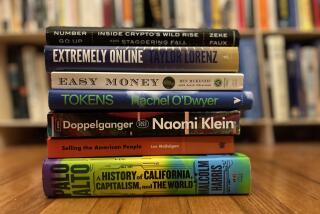Before the Web, a thriving electronic community
- Share via
In 1985, a precursor to the Internet was devised by two men in San Francisco.
One was Dr. Larry Brilliant, a maverick public health physician who now heads the Google Foundation. The other was Stewart Brand, a journalist and entrepreneur who had a knack for being present at revolutions in culture and technology.
Their invention was the Well, an electronic network intended to be a “virtual community” analogous to the communes founded in the hills of Northern California, Colorado and New Mexico. The Well let members discuss such topics as technology and the Grateful Dead via a form of instant messaging.
It is easy to spot what the Well of 1985 became: the current Web 2.0. The virtual community has been replicated in social networks such as MySpace and user-generated content such as YouTube.
Go back a further 20 years and you can see another root of the Internet: the counterculture revolution of the 1960s.
Brand, who hung out with Ken Kesey and the Merry Pranksters on the fringes of the Stanford University campus, was an instrumental figure in 1967.
His seminal act was to publish the Whole Earth Catalog, a kind of Sears catalog for hippies from which the Well got its name (Whole Earth ‘lectronic link). The catalog featured everything from tents to calculators.
The Internet has a similarly utopian quality: The cofounders of Google use “Don’t be evil” as their informal motto. Ventures such as Wikipedia, the volunteer-compiled online encyclopedia, are based on the belief that communities of volunteers can do things as well as, or better, than individuals in hierarchical organizations. News sites such as Digg use communities to signal priorities rather than “old media” editors.
The story of how the communes of the 1960s gave birth to the technology entrepreneurs of the last three decades is intriguing. One version has been told by John Markoff in “What the Dormouse Said: How the 60s Counterculture Shaped the Personal Computer Industry.” This one is recounted by Fred Turner, a Stanford academic, in greater detail and with a tendency to categorize things into submission.
For readers who make the effort, the book has many intriguing stories and larger-than-life characters. The largest character is Brand, an itinerant idealist who pops up all over the place as an impresario of change.
Brand married a fluid personal philosophy (“I’ve yet to figure out what capitalism is, but if it’s what we’re doing, I dig it,” he said in 1970) to an inquisitive mind and a taste for adventure.
In the 1980s and 1990s, Brand became a chronicler and philosopher of Silicon Valley, along with John Perry Barlow, Esther Dyson and others.
In 1984, he famously said: “Information wants to be free because the cost of getting it out is getting lower and lower all the time.” It is sometimes cited to justify piracy, ignoring the start of Brand’s statement: “Information wants to be expensive because it’s so valuable.”
Turner focuses on one irony of the personal computer and Internet revolution: It grew from government-funded military research in the postwar period.
The military-industrial complex required innovation that was dreamed up in cross-disciplinary laboratories such as Los Alamos in New Mexico and Oak Ridge in Tennessee. These became early models for the approach to innovation at Silicon Valley companies.
The 1960s revolutionaries raged against the power of the corporation and oppressive technology in the form of the mainframe computer. By taking to the hills, they wanted to return to a pretechnological state of nature.
Yet the children of the 1960s went on to invent the personal computer, sold by Steve Jobs at Apple Computer Inc. as a weapon against dull conformity. Technology had been reclaimed for the purposes of liberation.
Having pointed this out, Turner finishes. He leaves questions in the air about where the current wave of digital utopianism will end. The 1960s did not end with everyone living in communes, yet many of its ideals, such as female emancipation and liberation of youth, have been absorbed into Western culture.
What about Web 2.0? The Internet makes it easier for people to find one another, to form interest groups and to act against attitudes and actions they dislike. Web utopians draw the lesson that a revolution is upon us. User-generated content, they believe, will replace the information and entertainment selected and presented by the old-media establishment.
More likely is an accommodation between the old and new media. As the 1960s revolution showed, “Power to the people” is a hard idea to subdue.
From Wikipedia to Second Life, a community emerges every minute on the Internet. Even Brand could hardly have known what he was letting loose with the Well. But a digital utopia is no easier to sustain than one in real life.
*
Machine dreams
--
* From Counterculture to Cyberculture: Stewart Brand, the Whole Earth Network, and the Rise of Digital Utopianism
* By Fred Turner
* University of Chicago Press, $29, 354 pages
*
Source: Publisher
John Gapper is associate editor and chief business commentator of the Financial Times, in which this review first appeared.






